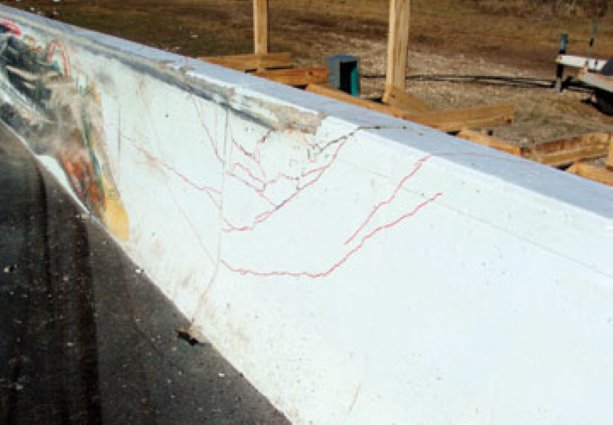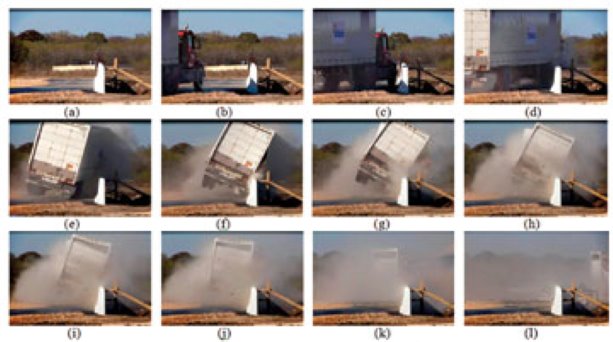The Ministry of Transportation of Ontario (MTO) recently approved a new design for Performance Level Three (PL-3) concrete traffic bridge barriers reinforced with glass fibre reinforced polymer (GFRP) rebar.
When the Ontario Ministry of Transportation (MTO) wants to test a less expensive alternative design for concrete traffic barriers, it doesn’t fool around. The ministry recently approved a new design for Performance Level Three (PL-3) concrete traffic bridge barriers reinforced with glass fibre reinforced polymer (GFRP) rebar — but only after impact tests were conducted using an actual tractor-trailer, the first such test of the product in North America.
The PL-3 concrete barriers are typically reinforced with stainless steel rebar. However, Combar, a new rebar product made by German company Schoeck, promised to cut barrier costs by reinforcing them with GFRP rebar. MTO had previously approved the use of PL-2 barriers reinforced with GFRP. However, the number of bends introduced into the rebar to properly anchor the barrier wall reinforcing into the deck weakens their design strength when compared to straight bars. While the bent rebar could safely withstand PL-2 barrier loads, it couldn’t withstand loads that might be applied to a PL-3 barrier.
The new product features straight sections of GFRP rebar with specially designed anchor heads made of a thermo-setting polymeric resin offering a compressive strength greater than normal grade concrete. The anchors end in a wide disk shape, which transfers load from the bar into the concrete.
“Before we could specify the use of the product in PL-3 barriers, we require crash testing according to the requirements of the National Cooperative Highway Research Program,” says Nicolas Theodor, head standards engineer, Highway Standards Branch, MTO.
The test was conducted by the Ryerson University engineering department in late 2010 at the Texas Transportation Institute crash testing facility at a cost of about $100,000, entirely financed by the product manufacturer.
The tests are conducted at arm’s-length from MTO, with video and photographic evidence presented to the ministry following the test session. The concrete barriers were fitted with GFRP bars of 16-mm nominal diameter, used both for vertical as well as horizontal reinforcement on the barrier face. Supplying the brute force: an actual tractor-trailer of 36,000-kg gross weight, traveling at a constant speed of 80 km/hr and striking the barrier at a 15-degree angle.
“They used a pick-up truck which drove alongside the transport, guiding it by remote control until it was time to steer it into the barrier,” says Theodor. “At a precise time, they directed the transport truck to crash into the barrier. The barrier is supposed to be both strong enough to keep the truck from going over the barrier and re-direct it back to the roadway. While the truck began to tip toward the barrier after impact, it straightened out and then slowed down. When it was over, the transport looked pretty mangled, but the occupant compartment looked fine and the truck remained on the road.”
Examination of the barrier revealed only minor cracks on both sides and an acceptable level of damage. The trial was followed by a pull-out test in which tension was applied to the rebar to ensure it remained imbedded in the concrete.
Quebec company Pultrall has since financed a similar test conducted by Ryerson University on its own rebar product, V-ROD. That product has also been approved by MTO for use in PL-3 barriers.
Theodor notes that the new rebar products have cut the cost of reinforcement for concrete PL-3 barriers by about 30 per cent, while maintaining full protection.
“That’s just what we like to see,” he says. “Healthy competition bringing these costs down for Ontario taxpayers.”

1/2
-
2/2
A closer look at the same barriers.
Photo: Ontario Ministry of Transportation


Recent Comments
comments for this post are closed